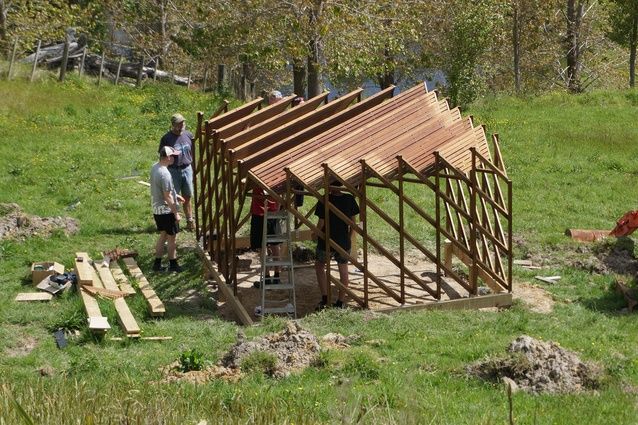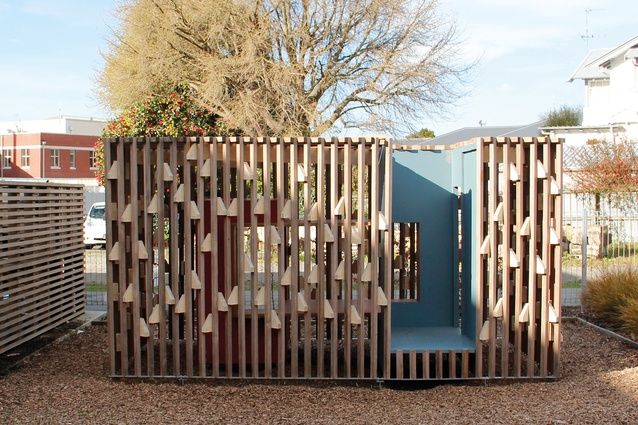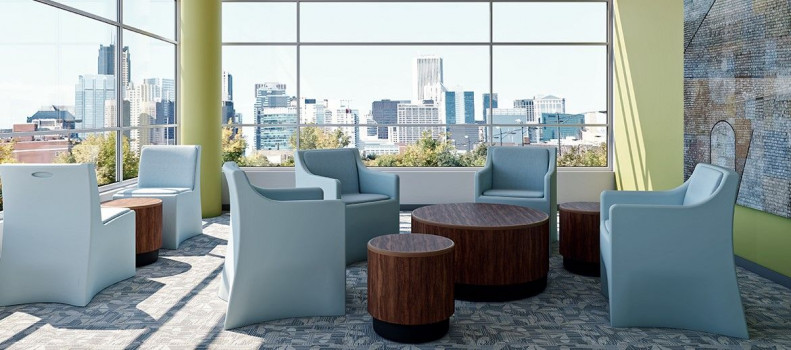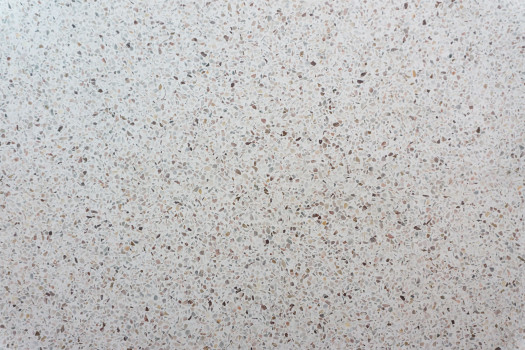Ways of Making




Professor Andrew Barrie discusses design-and-build using computer numerical control (CNC) machinery in a range of innovative, small-scale, timber-technology projects by students in his lab at the University of Auckland’s School of Architecture and Planning.
At the 2019 NZIA In:Situ conference, I had an intense conversation with two of the speakers, Slovenians Tina Gregorič and Aljoša Dekleva.1 They are architects who combine, as I do, teaching and architectural practice. Among the most fiercely held of their views were those on architectural education. Gregorič said of their own training: “We always questioned the teachers at the AA who didn’t have a practice. We were very sceptical of them.” Dekleva added: “It went beyond questioning – we simply didn’t trust them.” For Gregorič, students must learn by doing and hands-on experience of construction is critical: “You need to be exposed to at least one intense workshop of design-and-build – to work physically with wood or brick or concrete. We push the students to learn that conceptualising must lead to testing, prototyping, changes and, then, final results. It’s only if the one-to-one built result is still strong conceptually that all the thinking behind it is relevant.”
At the University of Auckland School of Architecture and Planning (SoAP), as at most schools of architecture, we wrestle with how to integrate this kind of teaching into the course. As part of our undergraduate programme, SoAP runs studios focused on full-scale construction – since 2005, we have run a series of second-year design courses in which groups of students design and build large temporary structures for special events. These events have included Auckland Architecture Week and, since 2010, the FESTA activities to enliven post-quake Christchurch. However, escalating health and safety requirements, having to resolve technical issues and the need for extra funding mean running such projects for a 120-plus year group of students places near-crippling demands on the teaching staff.
To provide more in-depth engagement with technology and construction, since 2009, senior lecturer John Chapman, a qualified engineer, ran a post-graduate Timber Technology seminar course in the fourth year of our five-year degree programme. Each semester, the course centred on the construction of a small, teacher-designed structure – seating shelters, a bandstand and so on – to be fabricated by students in SoAP’s workshops and erected in the School courtyard at the end of each semester.
This achieved the key course goals of exposing students to timber construction techniques and giving hands-on workshop experience but there was limited time to refine each design and more-complex structures or adventurous uses of technology were precluded. Importantly, few students were able to engage fully with one of the key principles presented through the course: the interconnectedness of design intentions, fabrication technologies and the pragmatics of construction.
In 2012, the course was redesigned such that the group of 20 students assisted with the construction of a design produced by a final-year ‘thesis’ student working under my supervision. The year-long thesis design project was an entranceway and waiting area at Onehunga Primary School (OPS). The school lacked a clearly defined pedestrian entrance and hoped that a pro bono project by architecture students could create a stronger street presence and ensure safety by separating pedestrian traffic from adjacent vehicles.
Student Melanie Pau took on the OPS project and, drawing on my work with timber structures made from repetitive elements, particularly reciprocal grillages, she structured her thesis as an exploration of the way in which timber structural systems could provide a distinctive, open-source construction system and promote the understanding of organic food. Within this theme, the thesis was organised as a series of designs, of which the OPS entranceway would be constructed at full scale as a ‘worked example’.
The project had all the complexities of a real project – indeed, it was a real project. Pau needed to link abstract architectural intentions to town planning issues, the client brief, construction methodologies, durability questions and budget constraints. She designed her entranceway to exploit a loophole in the New Zealand Building Code. The project was to be located on ‘designated land’ and, therefore, required an application for an Outline Plan of Works (equivalent to a Resource Consent) to be submitted to Council. However, as the structure remained under 10m2 in plan, it was exempt from the need to apply for Building Consent. Taking on this size constraint allowed more design freedom and removed potential delays associated with consent processes within the nine-month-long thesis programme.
Made from a system of prefabricated plywood elements, Pau’s design tested the limits of SoAP’s computer numerical control (CNC) machinery and workshops – it was, at that time, the largest permanent structure that had been built in the SoAP workshops. The project presented the students with an exemplar of concept-to-construction design thinking. Dozens of sheets of plywood were cut on the CNC machinery and laminated together by the seminar students in the workshops to produce 50 elements. A rigorous series of 1:1 prototypes was built to refine buildability and ensure ease of assembly. While it took a month to prepare the structure’s plywood members, this rigorous testing of detailing and fabrication meant that it took only 12 hours for the group of students to assemble the structure.
In completing the project, the students learned to innovate within limited budgets, understand timber’s material properties, and communicate and collaborate with their peers. The new course structure resulted in a number of benefits: it creates a new model for the construction of student projects that are of long-term benefit to the community; it creates connections between year levels which aid the sharing and accumulation of knowledge of timber construction, with ideas and experience being developed and passed down through the student cohort; and, it provides firsthand experience of full-scale project management. Perhaps most importantly, it pushes the level of timber design and technological engagement to a much higher level.
Beyond benefiting OPS and the students constructing the structure, the project pointed to a new way of working at SoAP, now described as a ‘lab’. Pau’s project was very well received by OPS, which subsequently requested the construction of further structures. Pau’s Outline Plan of Works included spaces for two further 10m2 structures and, in 2013, two students completed these structures as their own thesis projects.
In 2014, Henderson High School stepped forward to request structures as part of the rejuvenation of its grounds – eight projects have been completed or are under way there – and more recent projects have been completed for a children’s playground in Christchurch and a garden in Northland. The 13 projects produced over eight years have been supported by industry, with many partners (Resene, Spax, Abodo, PlaceMakers, engineering firm Ruamoko Solutions, the WIDE Trust and others) donating or providing discounts on materials and services. Since Chapman’s retirement, the seminar course has been run by energetic teaching fellow Matt Liggins.
This vertical teaching structure (that is, involving students from more than one year group) provides the freedom to experiment in a way that would be difficult to achieve in other environments. The projects have sought innovations of various kinds – the creation of structural variety with repetitive timber elements or joints, the development of innovative timber structural systems and the use of CNC milling to create new timber jointing techniques.

Heyuan Lu’s project, for example, borrowed the interlocking form of a Japanese puzzle to create a lattice of repeating joints by which long timbers supporting a roof were able to form a ‘cloud’ – think wooden Meccano, in which the pieces aren’t bolted together but pass through each other in three dimensions. Cheryl Wallbridge’s structure employs milled ‘patches’ of plywood, which interlock with solid timber sticks as both structural joints and stiffeners. The plywood masks the layout of the sticks to produce a very thin, inscrutable structure that can turn corners with no change to the pattern.
Many of the projects have received international and national awards – projects have twice received the international Bentley Systems’ Scott Lofgren Award for engineering innovation, and a number of projects have received Gold Pins at the Best Awards and nods at the New Zealand Timber Design Awards.
The structures produced in recent years have explored the use of solid timber – structures fabricated from relatively slender structural elements machined with relatively complex joints. This exposed something of a gap in the spectrum of CNC fabrication options available in New Zealand. In the construction industry generally, huge, highly specialised CNC machines are used to fabricate heavy primary structural members digitally, while smaller but more widely available CNC machines are used to mill sheet materials into small internal elements, such as parts for cabinetry. However, smaller structural and finishing timber elements are typically fabricated by hand on the construction site.
The focus of Dylan Waddell’s project was to devise a methodology for efficiently milling such elements en masse using widely available flat-bed CNC machines. This involved developing digital processes for modelling elements and preparing cutting files, as well as creating a jig system that allows elements – including elements much bigger than these relatively small machines are intended to accommodate – to be secured rapidly in the milling machine, accurately milled and removed for assembly. The methodology was tested in a structure that employs shallow but highly accurate partial lap joints, creating rigidity in a frame that looks like it might blow away in a stiff wind.

The methodology developed in this project is currently being extended to produce a project for the 2020 Venice Biennale. Based on the School’s track record with timber structures, SoAP has been invited to contribute a 30m2 timber pavilion to the Biennale as part of an international exhibition on the role of timber in urban resilience. Testing the limits of the new methodology, the Venice project is a larger and more complex structure that uses a cunning diagonal geometry to create a basket-like building with ‘seamless’ corner joints.
Readers might wonder about the point of attempting to innovate in this way. Cynics may dismiss such experimentation as the blind pursuit of novelty, as obsessive tinkering. Mies’ famous quip – “I don’t want to be interesting; I want to be good” – would likely be offered up in support of this assessment. Indeed, architectural history is littered with intensely considered prototypical design systems that have been used only once. In the architecture world, innovation can, perversely, discourage its own adoption, with distinctive technologies or approaches being avoided by other architects because of their association with the figures who developed them – witness the way in which no other architect has used cardboard tubes, despite their economic and ecological advantages, for fear of being branded a Shigeru Ban imitator.
But Mies was, of course, being disingenuous. He was responsible for some of the most important innovations of the 20th century, to the point where ‘Miesian’ characterises an important and still-operative approach to design. Our innovators provide the data points that accumulate to define our architectural history. Ways of making align with ways of thinking and of living; if we didn’t constantly seek out new ways of making, our architecture would soon detach from our social and cultural evolution.
Much of an architect’s skill is about finding freedoms, finding ways in which to do something interesting or to make something good within the constraints of a given situation. The projects described here were produced by students and teachers at a school of architecture: an environment that, in many ways, is highly constrained. They represent a way to meet Tina Gregorič’s admonition for architecture students to learn how to link concepts and built results. As she advocated, honing that skill, and building the capacity and confidence to seek out such connections is at the core of our task as architects.
Footnotes:
1. See Barrie, Andrew, Tina Gregorič & Aljoša Dekleva, ‘This is Normal: A conversation with Dekleva Arhitekti’, Block 10 (2019), pp. 01–02.




 Indonesia
Indonesia
 New Zealand
New Zealand
 Philippines
Philippines
 Hongkong
Hongkong
 Singapore
Singapore
 Malaysia
Malaysia







